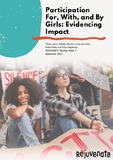Participation For, With, and By Girls: Evidencing Impact
| dc.contributor.author | Lewin, Tessa | |
| dc.contributor.author | Cannon, Mariah | |
| dc.contributor.author | Johnson, Vicky | |
| dc.contributor.author | Philip, Raisa Anna | |
| dc.contributor.author | Raghavan, Priya | |
| dc.date.accessioned | 2023-09-13T10:39:10Z | |
| dc.date.available | 2023-09-13T10:39:10Z | |
| dc.date.issued | 2023-09-14 | |
| dc.identifier.citation | Lewin, T.; Cannon, M.; Johnson, V.; Philip, R. and Raghavan, P. (2023) Participation For, With, and By Girls: Evidencing Impact, REJUVENATE Working Paper 2, Brighton: Institute of Development Studies, DOI: 10.19088/REJUVENATE.2023.001 | en |
| dc.identifier.isbn | 978-1-80470-133-1 | |
| dc.identifier.uri | https://opendocs.ids.ac.uk/opendocs/handle/20.500.12413/18107 | |
| dc.description.abstract | This paper presents the findings of a review of publicly available, published evidence on the efficacy of development projects that self-identify as ‘girl-led’, both within academic literature and from established organisations working with girls. What is meant by ‘girl-led’, of course, varies hugely. Terms such as girl-led, girl-centred, and girl-focused are often defined fluidly and used interchangeably by various implementation agencies. Because our review contained a wide and diverse range of programme interventions, we divided this range into three categories during our analysis – for, with, and by girls. This paper focuses on ‘girl-led’ work, rather than, for example, a gender-based approach to addressing girls’ rights. A significant proportion of development practice by a range of stakeholders including funders, practitioners, academics, corporates, and governments focus their programmes on young women and girls. We set out to articulate (and evidence) why there are gaps in terms of what evidence of impact is available, particularly in relation to substantively participatory work with girls. We also wanted to show why the collection of particular forms of evidence (quantitative and outcomes based) is often not desirable (for funders, practitioners, and participants) or appropriate in the context of participatory work, because of the limits to the type of information that it produces. Our review suggests that we need to carefully interrogate work that claims to be girl-led, and ask further questions of it, in terms of both how this classification is understood by those using it, and in relation to the extent of girls’ participation at each stage of the programme cycle. It suggests, also, that while substantive participation may not always be appropriate (because of, for example, budget, or time, or ethical concerns), where possible, engaging girls fully in design, implementation, and evaluation, can significantly augment the value of each of these stages of a programme. | en |
| dc.language.iso | en | en |
| dc.publisher | Institute of Development Studies | en |
| dc.relation.ispartofseries | REJUVENATE Working Paper;2 | |
| dc.rights | This is an Open Access paper distributed under the terms of the Creative Commons Attribution 4.0 International licence (CC BY), which permits unrestricted use, distribution, and reproduction in any medium, provided the original authors and source are credited and any modifications or adaptations are indicated. | en |
| dc.rights.uri | http://creativecommons.org/licenses/by/4.0/ | en |
| dc.subject | Children and Youth | en |
| dc.subject | Participation | en |
| dc.title | Participation For, With, and By Girls: Evidencing Impact | en |
| dc.type | Series paper (IDS) | en |
| dc.rights.holder | Institute of Development Studies | en |
| dc.identifier.team | Participation Power and Social Change | en |
| dc.identifier.doi | 10.19088/REJUVENATE.2023.001 | |
| dcterms.dateAccepted | 2023-09-14 | |
| rioxxterms.funder | Default funder | en |
| rioxxterms.identifier.project | Default project | en |
| rioxxterms.version | VoR | en |
| rioxxterms.versionofrecord | 10.19088/REJUVENATE.2023.001 | en |
| rioxxterms.funder.project | 43db2a26-ab53-4dd1-873f-cff26a51d1e0 | en |
Files in this item
This item appears in the following Collection(s)
-
IDS Research [1671]
Except where otherwise noted, this item's license is described as This is an Open Access paper distributed under the terms of the Creative Commons Attribution 4.0 International licence (CC BY), which permits unrestricted use, distribution, and reproduction in any medium, provided the original authors and source are credited and any modifications or adaptations are indicated.


